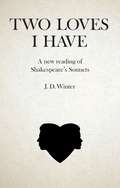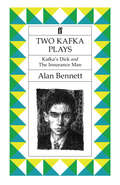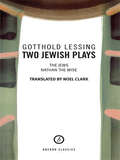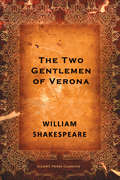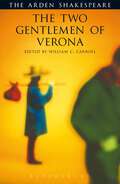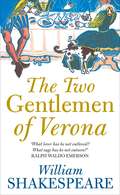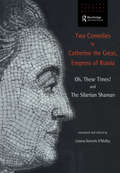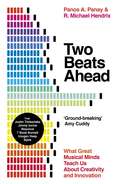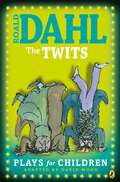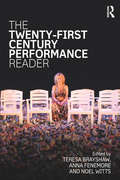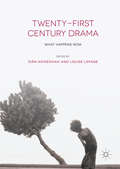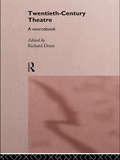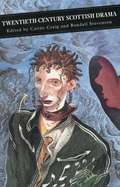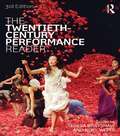- Table View
- List View
Two Loves I Have: A New Reading of Shakespeare's Sonnets
by J. D. WinterPerhaps the most astonishing set of personal poems ever written, Shakespeare's Sonnets have both delighted and puzzled readers down the ages. Two Loves I Have is a reading of the sequence that brings the four characters involved to life. The 'fair, kind and true' young man to whom the majority of poems are addressed, the woman 'as black as hell, as dark as night' who dominates a part of the narrator's inner landscape against his will, the narrator himself, who at times is unexpectedly wholly at ease with his mistress, but at other times is sunk in a form of self-loathing, and whom nothing on earth will deter in his devotion to the young man ... these three play out a drama as fierce as that in any of the author's plays. And the author himself, at some remove behind the narrator, is the shadowy fourth character. Did he invent the young man and the Dark Lady? Did he adapt an existing situation in his life or indeed record it simply as it was? Whatever the historical fact, which can never be known, the poetic situation is enthralling. Without insisting on any particular view, Two Loves I Have (from sonnet 144) allows the reader a vista of the whole sonnet sequence, and a sense of its shifting currents. J. D. Winter carefully elucidates each individual poem, thus enabling the reader not only to come to terms with their outward meaning but to appreciate the rhetorical flow and the poet's idiosyncratic use of the sonnet-form itself. The sonnet sequence has been a comparatively neglected part of the Shakespearean canon. The 400th anniversary of Shakespeare's death in 2016 is an appropriate time to shed a new light upon the poems.
Two Kafka Plays: Kafka's Dick & The Insurance
by Alan Bennett'You have to keep your ears open for Alan Bennett's Insurance Man. It had visual impact so powerful that you were in danger of missing some very good lines simply because nobody spoke them in close up; you had to catch them on the wing. And if there was one line that summed up both Bennett's play and Kafka's novel The Trial, which provided some of this framework, that line was "Just because you're the injured party, it doesn't mean you're not guilty".' GuardianKafka himself figures in these two brilliant scripts: one a hilarious comedy, the other a profound and searching drama. This edition includes an introduction by Alan Bennett.
Two Jewish Plays: The Jews And Nathan The Wise (Oberon Modern Plays)
by Gotthold LessingGotthold Lessing (1729-81), playwright, critic, humanist philosopher and polemicist was a leading figure of the German enlightnement era. From his immense literary output two plays stand out - The Jews and Nathan the Wise - for the passion of the writing and the timeless urgency of the message. Though differering greatly in form and content, both plays are eloquent pleas for human beings to desist from mutual persecution on racial or religious grounds. The relevance of Lessing's thinking in today's world is all too clear. They are published here in new English versions by the award-winning translator, Noel Clark.
The Two Gentlemen of Verona
by William ShakespeareProteus's duplicity is revealed when the beautiful Julia follows him to Milan only to learn his affections have turned to another.
The Two Gentlemen of Verona: Third Series (The Arden Shakespeare Third Series)
by William ShakespeareTwo Gentlemen of Verona is commonly agreed to be Shakespeare's first comedy, and probably his first play. A comedy built around the confusions of doubling, cross - dressing and identity, it is also a play about the ideal of male friendship and what happens to those friendships when men fall in love.William Carroll's engaging Introduction focuses on the traditions and sources that stand behind the play and explores Shakespeare's unique and bold treatment of them. Special attention is given to the strong female figure of Julia and the controversial final scene.
The Two Gentlemen of Verona: With The Story Of The Shepherdess Felismena (The\arden Shakespeare Third Ser.)
by William Shakespeare Russell JacksonLeaving behind both home and beloved, a young man travels to Milan to meet his closest friend. Once there, however, he falls in love with his friend's new sweetheart and resolves to seduce her. Love-crazed and desperate, he is soon moved to commit cynical acts of betrayal. And comic scenes involving a servant and his dog enhance the play's exploration how passion can prove more powerful than even the strongest loyalty owed to a friend.
Two Comedies by Catherine the Great, Empress of Russia: Oh, These Times! and The Siberian Shaman
by Lurana Donnels O'MalleyCatherine the Great (1729-1796) wrote over two dozen plays and operettas, but not until this edition has a complete translation of any of them been available to an English- speaking readership. Oh, These Times (1772) is a satirical attack on many vices Catherine wished to root out from her society: religious hypocrisy, superstition and slander. The main character, Mrs. Pious, is a superficially religious old woman who resembles Moliere's Tartuffe. Catherine again sets her sights on superstition in The Siberian Shaman (1786), this time by satirizing shamanism as a deceitful profession which preys on the gullible. This play was part of a group of three plays usually known as Catherine's "anti-masonic" trilogy, written as a warning against the growing influence of the freemasons. In a comprehensive introduction, Lurana Donnels O'Malley relates the plays to Catherine's status and philosophy.
Two Comedies by Catherine the Great, Empress of Russia: Oh, These Times! and The Siberian Shaman
by Lurana Donnels O'MalleyCatherine the Great (1729-1796) wrote over two dozen plays and operettas, but not until this edition has a complete translation of any of them been available to an English- speaking readership. Oh, These Times (1772) is a satirical attack on many vices Catherine wished to root out from her society: religious hypocrisy, superstition and slander. The main character, Mrs. Pious, is a superficially religious old woman who resembles Moliere's Tartuffe. Catherine again sets her sights on superstition in The Siberian Shaman (1786), this time by satirizing shamanism as a deceitful profession which preys on the gullible. This play was part of a group of three plays usually known as Catherine's "anti-masonic" trilogy, written as a warning against the growing influence of the freemasons. In a comprehensive introduction, Lurana Donnels O'Malley relates the plays to Catherine's status and philosophy.
Two Beats Ahead: What Great Musical Minds Teach Us About Creativity and Innovation
by Panos A. Panay R. Michael Hendrix'A roadmap for innovators, entrepreneurs and those seeking new avenues for exploring and reimagining the future' Deepak Chopra 'Groundbreaking' Amy Cuddy, bestselling author of Presence Musicians know how to stay ahead of the beat. As Chance the Rapper said 'Technology moves faster than business and music moves faster than technology.' Forced to find new ways to adapt to accelerating change, musicians are masters of innovation. Demystifying their process for the first time, Two Beats Ahead reveals what we can learn from today's top musical minds. Drawing from interviews and case studies with masterminds like Quincy Jones, Jimmy Iovine, Dr. Dre, Lady Gaga, Beyoncé and Pharrell Williams, as well as leaders at Google X and Amazon, this book identifies the key lessons and skills musicians can teach us about innovation. Inspired by creative geniuses, you'll learn how to:· Listen more carefully and thoughtfully · Experiment more freely · Collaborate with a more diverse cast of partners· Demo and prototype like a jazz musician · Perform under the spotlight· Improvise like a great bebop ensemble Two Beats Ahead is a creativity crash-course for anyone who wants to be more entrepreneurial or lead an innovative team.'Inspiration for anyone looking to expand the reach of their creativity' Tim Brown, author of Change By Design'Based on their course at Berklee, Michael and Panos show that a musician's perspective, much like a designers perspective, can unlock inspiration and innovation, no matter who you are' David Kelley, founder of IDEO and the Stanford d.school
The Twits: Plays for Children (The\raven Rock Primary Novel Study Collection)
by Roald Dahl David WoodA collection of six fun-to-perform playlets based on Roald Dahl's bestselling story.Each short play, based on THE TWITS, highlights the key points in the story and some can be acted by groups of children while others only need a couple of actors.Similar format to the The BFG, and The Witches: Plays for ChildrenAdapted by David Wood, a central figure in children's theatre (most recently Goodnight Mister Tom).
Twist of Gold (Oberon Modern Plays)
by Michael Morpurgo Simon ReadeWith famine gripping Ireland, Sean and Annie have just one chance of survival - they must find their father. Leaving their dying mother behind, they travel across rough seas to America. With only the gold torch that Annie wears as a necklace to protect them, they embark on a long and dangerous journey. But will they ever be reunited with their family?Twist of Gold is an epic adventure, a classic novel by the masterful storyteller and author of War Horse, Michael Morpurgo.
Twins in Early Modern English Drama and Shakespeare (Routledge Studies in Renaissance Literature and Culture)
by Daisy MurrayThis volume investigates the early modern understanding of twinship through new readings of plays, informed by discussions of twins appearing in such literature as anatomy tracts, midwifery manuals, monstrous birth broadsides, and chapbooks. The book contextualizes such dramatic representations of twinship, investigating contemporary discussions about twins in medical and popular literature and how such dialogues resonate with the twin characters appearing on the early modern stage. Garofalo demonstrates that, in this period, twin births were viewed as biologically aberrant and, because of this classification, authors frequently attempt to explain the phenomenon in ways which call into question the moral and constitutional standing of both the parents and the twins themselves. In line with current critical studies on pregnancy and the female body, discussions of twin births reveal a distrust of the mother and the processes surrounding twin conception; however, a corresponding suspicion of twins also emerges, which monstrous birth pamphlets exemplify. This book analyzes the representation of twins in early modern drama in light of this information, moving from tragedies through to comedies. This progression demonstrates how the dramatic potential inherent in the early modern understanding of twinship is capitalized on by playwrights, as negative ideas about twins can be seen transitioning into tragic and tragicomic depictions of twinship. However, by building toward a positive, comic representation of twins, the work additionally suggests an alternate interpretation of twinship in this period, which appreciates and celebrates twins because of their difference. The volume will be of interest to those studying Shakespeare and Renaissance Literature in relation to the History of Emotions, the Body, and the Medical Humanities.
Twins in Early Modern English Drama and Shakespeare (Routledge Studies in Renaissance Literature and Culture)
by Daisy MurrayThis volume investigates the early modern understanding of twinship through new readings of plays, informed by discussions of twins appearing in such literature as anatomy tracts, midwifery manuals, monstrous birth broadsides, and chapbooks. The book contextualizes such dramatic representations of twinship, investigating contemporary discussions about twins in medical and popular literature and how such dialogues resonate with the twin characters appearing on the early modern stage. Garofalo demonstrates that, in this period, twin births were viewed as biologically aberrant and, because of this classification, authors frequently attempt to explain the phenomenon in ways which call into question the moral and constitutional standing of both the parents and the twins themselves. In line with current critical studies on pregnancy and the female body, discussions of twin births reveal a distrust of the mother and the processes surrounding twin conception; however, a corresponding suspicion of twins also emerges, which monstrous birth pamphlets exemplify. This book analyzes the representation of twins in early modern drama in light of this information, moving from tragedies through to comedies. This progression demonstrates how the dramatic potential inherent in the early modern understanding of twinship is capitalized on by playwrights, as negative ideas about twins can be seen transitioning into tragic and tragicomic depictions of twinship. However, by building toward a positive, comic representation of twins, the work additionally suggests an alternate interpretation of twinship in this period, which appreciates and celebrates twins because of their difference. The volume will be of interest to those studying Shakespeare and Renaissance Literature in relation to the History of Emotions, the Body, and the Medical Humanities.
The Twilight Zone: Based On Stories By Rod Serling, Charles Beaumont And Richard Matheson (Oberon Modern Plays)
by Rod Serling Richard Matheson Charles Beaumont Anne WashburnBetween light and shadow, science and superstition, fear and knowledge, is a dimension of imagination. An area we call the Twilight Zone.Adapted by Anne Washburn (Mr Burns) and directed by Olivier Award-winner Richard Jones, this world premiere production of the acclaimed CBS Television Series The Twilight Zone lands on stage for the first time in its history. Or its present. Or its future.
The Twenty-First Century Performance Reader
by Teresa Brayshaw Anna Fenemore Noel WittsThe Twenty-First Century Performance Reader combines extracts from over 70 international practitioners, companies, collectives and makers from the fields of Dance, Theatre, Music, Live and Performance Art, and Activism to form an essential sourcebook for students, researchers and practitioners. This is the follow-on text from The Twentieth-Century Performance Reader, which has been the key introductory text to all kinds of performance for over 20 years since it was first published in 1996. Contributions from new and emerging practitioners are placed alongside those of long-established individual artists and companies, representing the work of this century’s leading practitioners through the voices of over 140 individuals. The contributors in this volume reflect the diverse and eclectic culture of practices that now make up the expanded field of performance, and their stories, reflections and working processes collectively offer a snapshot of contemporary artistic concerns. Many of the pieces have been specially commissioned for this edition and comprise a range of written forms – scholarly, academic, creative, interviews, diary entries, autobiographical, polemical and visual. Ideal for university students and instructors, this volume’s structure and global span invites readers to compare and cross-reference significant approaches outside of the constraints and simplifications of genre, encouraging cross-disciplinary understandings. For those who engage with new, live and innovative approaches to performance and the interplay of radical ideas, The Twenty-First Century Performance Reader is invaluable.
The Twenty-First Century Performance Reader
by Teresa Brayshaw Anna Fenemore Noel WittsThe Twenty-First Century Performance Reader combines extracts from over 70 international practitioners, companies, collectives and makers from the fields of Dance, Theatre, Music, Live and Performance Art, and Activism to form an essential sourcebook for students, researchers and practitioners. This is the follow-on text from The Twentieth-Century Performance Reader, which has been the key introductory text to all kinds of performance for over 20 years since it was first published in 1996. Contributions from new and emerging practitioners are placed alongside those of long-established individual artists and companies, representing the work of this century’s leading practitioners through the voices of over 140 individuals. The contributors in this volume reflect the diverse and eclectic culture of practices that now make up the expanded field of performance, and their stories, reflections and working processes collectively offer a snapshot of contemporary artistic concerns. Many of the pieces have been specially commissioned for this edition and comprise a range of written forms – scholarly, academic, creative, interviews, diary entries, autobiographical, polemical and visual. Ideal for university students and instructors, this volume’s structure and global span invites readers to compare and cross-reference significant approaches outside of the constraints and simplifications of genre, encouraging cross-disciplinary understandings. For those who engage with new, live and innovative approaches to performance and the interplay of radical ideas, The Twenty-First Century Performance Reader is invaluable.
Twenty-First Century Musicals: From Stage to Screen
by George RodosthenousTwenty-First Century Musicals stakes a place for the musical in today’s cinematic landscape, taking a look at leading contemporary shows from their stage origins to their big-screen adaptations. Each chapter offers a new perspective on a single musical, challenging populist narratives and exploring underlying narratives and sub-texts in depth. Themes of national identity; race, class and gender; the ‘voice’ and ‘singing live’ on film; authenticity; camp sensibilities; and the celebration of failure are addressed in a series of questions including: How does the film adaptation provide a different viewing experience from the stage version? What themes are highlighted in the film adaptation? What does the new casting bring to the work? Do camera angles dictate a different reading from the stage version? What is lost/gained in the process of adaptation to film? Re-interpreting the contemporary film musical as a compelling art form, Twenty-First Century Musicals is a must-read for any student or scholar keen to broaden their understanding of musical performance.
Twenty-First Century Musicals: From Stage to Screen
by George RodosthenousTwenty-First Century Musicals stakes a place for the musical in today’s cinematic landscape, taking a look at leading contemporary shows from their stage origins to their big-screen adaptations. Each chapter offers a new perspective on a single musical, challenging populist narratives and exploring underlying narratives and sub-texts in depth. Themes of national identity; race, class and gender; the ‘voice’ and ‘singing live’ on film; authenticity; camp sensibilities; and the celebration of failure are addressed in a series of questions including: How does the film adaptation provide a different viewing experience from the stage version? What themes are highlighted in the film adaptation? What does the new casting bring to the work? Do camera angles dictate a different reading from the stage version? What is lost/gained in the process of adaptation to film? Re-interpreting the contemporary film musical as a compelling art form, Twenty-First Century Musicals is a must-read for any student or scholar keen to broaden their understanding of musical performance.
Twenty-First Century Drama: What Happens Now
by Siân Adiseshiah Louise LePageWithin this landmark collection, original voices from the field of drama provide rich analysis of a selection of the most exciting and remarkable plays and productions of the twenty-first century. But what makes the drama of the new millenium so distinctive? Which events, themes, shifts, and paradigms are marking its stages? Kaleidoscopic in scope, Twenty-First Century Drama: What Happens Now creates a broad, rigorously critical framework for approaching the drama of this period, including its forms, playwrights, companies, institutions, collaborative projects, and directors. The collection has a deliberately British bent, examining established playwrights – such as Churchill, Brenton, and Hare – alongside a new generation of writers – including Stephens, Prebble, Kirkwood, Bartlett, and Kelly. Simultaneously international in scope, it engages with significant new work from the US, Japan, India, Australia, and the Netherlands, to reflect a twenty-first century context that is fundamentally globalized. The volume’s central themes – the financial crisis, austerity, climate change, new forms of human being, migration, class, race and gender, cultural politics and issues of nationhood – are mediated through fresh, cutting-edge perspectives.
Twentieth Century Theatre: A Sourcebook
by Richard DrainTwentieth Century Theatre: A Sourcebook is an inspired handbook of ideas and arguments on theatre. Richard Drain gathers together a uniquely wide-ranging selection of original writings on theatre by its most creative practitioners - directors, playwrights, performers and designers, from Jarry to Grotowski and Craig. These key texts span the twentieth century, from the onset of modernism to the present, providing direct access to the thinking behind much of the most stimulating theatre the century has had to offer, as well as guidelines to its present most adventurous developments. Setting theory beside practice, these writings bring alive a number of vital and continuing concerns, each of which is given full scope in five sections which explore the Modernist, Political, Inner and Global dimensions of twentieth century theatre. Twentieth Century Theatre: A Sourcebook provides illuminationg perspectives on past history, and throws fresh light on the sources and development of theatre today. This sourcebook is not only an essential and versatile collection for students at all levels, but also directed numerous devised shows which have toured to theatres, schools, community centres and prisons.
Twentieth Century Theatre: A Sourcebook
by Richard DrainTwentieth Century Theatre: A Sourcebook is an inspired handbook of ideas and arguments on theatre. Richard Drain gathers together a uniquely wide-ranging selection of original writings on theatre by its most creative practitioners - directors, playwrights, performers and designers, from Jarry to Grotowski and Craig. These key texts span the twentieth century, from the onset of modernism to the present, providing direct access to the thinking behind much of the most stimulating theatre the century has had to offer, as well as guidelines to its present most adventurous developments. Setting theory beside practice, these writings bring alive a number of vital and continuing concerns, each of which is given full scope in five sections which explore the Modernist, Political, Inner and Global dimensions of twentieth century theatre. Twentieth Century Theatre: A Sourcebook provides illuminationg perspectives on past history, and throws fresh light on the sources and development of theatre today. This sourcebook is not only an essential and versatile collection for students at all levels, but also directed numerous devised shows which have toured to theatres, schools, community centres and prisons.
Twentieth Century Scottish Drama (Canongate Classics #98)
by Cairns Craig Randall StevensEdited and introduced by Cairns Craig and Randall Stevenson. Ever since the major revival of dramatic writing and production in the 1970s, the style and the subject matter of Scottish writing for stage and screen has been a continuing influence on our contemporary culture, exciting, offending and challenging audiences in equal measure. Yet modern Scottish drama has a history of controversy, conflict and entertainment going back to the 1920s, notable at every turn for the vigour of its language and its direct confrontation with telling issues. The plays in this anthology offer a unique chance to grasp the different topics and also the recurrent themes of Scottish drama in the twentieth century. Gathered together in a single omnibus volume, there is the poetic eeriness of Barrie and the political commitment of Joe Corrie and Sue Glover; there is the Brechtian debate of Bridie and the verbal brilliance of John Byrne and Liz Lochhead; there is working-class experience and feminist insight; broad Scots and existential anxiety; street realism and a meeting with the devil; social injustice and raucous humour; historical comedy and tragic loss. Here is both the breadth and the continuity of the modern Scottish tradition in a single volume.
The Twentieth Century Performance Reader
by Teresa Brayshaw Noel WittsThe Twentieth-Century Performance Reader has been the key introductory text to all types of performance for over fifteen years. Extracts from over fifty practitioners, critics and theorists from the fields of dance, drama, music, theatre and live art form an essential sourcebook for students, researchers and practitioners. This carefully revised third edition offers focus on contributions from the world of music, and also privileges the voices of practitioners themselves ahead of more theoretical writing. A bestseller since its original publication in 1996, this new edition has been expanded to include contributions from: Bobby Baker; Joseph Beuys; Rustom Bharucha; Anne Teresa de Keersmaeker; Hanns Eisler; Karen Finley; Philip Glass; Guillermo Gómez-Peña; Matthew Goulish; Martha Graham; Wassily Kandinsky; Jacques Lecoq; Hans-Thies Lehmann; George Maciunas; Ariane Mnouchkine; Meredith Monk; Lloyd Newson; Carolee Schneemann; Gertrude Stein; Bill Viola. Each extract is fully supplemented by a contextual summary, a biography of the writer, and suggestions for further reading. The volume’s alphabetical structure invites the reader to compare and cross-reference major writings on all types of performance outside of the constraints and simplifications of genre, encouraging cross-disciplinary understandings. All who engage with live, innovative performance, and the interplay of radical ideas, will find this collection invaluable.
The Twentieth Century Performance Reader
by Teresa Brayshaw Noel WittsThe Twentieth-Century Performance Reader has been the key introductory text to all types of performance for over fifteen years. Extracts from over fifty practitioners, critics and theorists from the fields of dance, drama, music, theatre and live art form an essential sourcebook for students, researchers and practitioners. This carefully revised third edition offers focus on contributions from the world of music, and also privileges the voices of practitioners themselves ahead of more theoretical writing. A bestseller since its original publication in 1996, this new edition has been expanded to include contributions from: Bobby Baker; Joseph Beuys; Rustom Bharucha; Anne Teresa de Keersmaeker; Hanns Eisler; Karen Finley; Philip Glass; Guillermo Gómez-Peña; Matthew Goulish; Martha Graham; Wassily Kandinsky; Jacques Lecoq; Hans-Thies Lehmann; George Maciunas; Ariane Mnouchkine; Meredith Monk; Lloyd Newson; Carolee Schneemann; Gertrude Stein; Bill Viola. Each extract is fully supplemented by a contextual summary, a biography of the writer, and suggestions for further reading. The volume’s alphabetical structure invites the reader to compare and cross-reference major writings on all types of performance outside of the constraints and simplifications of genre, encouraging cross-disciplinary understandings. All who engage with live, innovative performance, and the interplay of radical ideas, will find this collection invaluable.
